The long-living piston-powered legend
Although some of the most prominent WW2 aircraft, such as the F4U Corsair or the P51 Mustang, constantly upgraded, still took part in various combats in the 1970-80s, the Douglas Skyraider is certainly one of these surprises. Known at first as the AD Skyraide this very robust and reliable single-seat attack aircraft was in service from 1946, virtually to the early 1980s, making a remarkably long and successful career for a piston-engined model in turboprop and jet age. For these longevity reasons it was also nicknamed lately the “Spad”, a reference to the French WWI fighter. In the 1960s indeed when it soldiered over Vietnam, there was as much time since its first flight from the Spads in US service.
In any case, its probably these old school recipes which allowed this venerable “bomb truck” to see so much active service for decades, until the early 1970s in the US Navy and marines alone. Cheap and simple to maintain, requiring a single pilot as crew, extraordinarily resilient, this dependable beast of burden flew the most perilous missions deep in enemy territory and almost always came back to tell the tale. Inspirational, it was never replaced by the small A4 Skyhawk, but it’s only worthy successor, the legendary A10 Warthog, which went to the USAAF while officially the Navy replaced it by the Vought A7 Corsair II. The “A” standing for attack, was also the reset of this peacetime designation, and it was the first to inaugurate this new line.
Birth of a legend (1943)
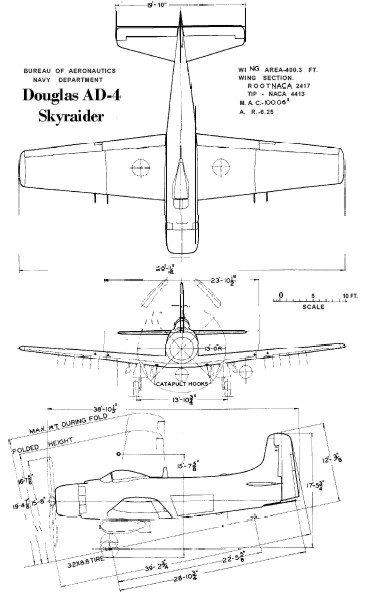 In 1943 an official requirement was published for a carrier-based attack aircraft, single-seat, long-range, and high performance model capable of acting as dive and torpedo bomber. It was supposed to replace the Douglas SBD Dauntless, the Curtiss SB2C Helldiver and the Grumman TBF Avenger as a “universal platform”. The single pilot was now possible by using more automated systems, radar, and better radios. The famous specification, also looked forward in UK, trigerred a whole generation of competitors, among which was the Martin AM Mauler and the Grumman AF Guardian. Both were far less successful and only built in small numbers despite more promising features.
In 1943 an official requirement was published for a carrier-based attack aircraft, single-seat, long-range, and high performance model capable of acting as dive and torpedo bomber. It was supposed to replace the Douglas SBD Dauntless, the Curtiss SB2C Helldiver and the Grumman TBF Avenger as a “universal platform”. The single pilot was now possible by using more automated systems, radar, and better radios. The famous specification, also looked forward in UK, trigerred a whole generation of competitors, among which was the Martin AM Mauler and the Grumman AF Guardian. Both were far less successful and only built in small numbers despite more promising features.
Douglas, which already provided the Dauntless to the USN, was equal favorite in a competition in which many great manufacturers competed for a potentially still very lucrative market postwar. The Douglas XBT2D as first designated was Designed by Ed Heinemann of the Douglas Aircraft Company and submitted in early 1944. Accepted, it was followed by an order of a few prototypes on 6 July 1944 as the XBT2D-1. In seven month, the prototype was built and tested at Douglas, making its first flight on 18 March 1945, showing only heatlhy characteristics and practicaly no serious fixes were done. This was followed logically by official tests at the Naval Air Test Center (NATC) in April 1945.
With less emeregency due to the end of the war in Europe and a situation stabilized in the Pacific, tests and fixes dragged on until December 1946, and its designation was changed to the postwar “AD-1”, “A” standard for “attack” and “D” for the manufacturer, Douglas. On order was made for a first batch a delivery to the first fleet squadron was made to VA-19A in early 1947. Needless to say, this model, although designed duting WW2, never fought.
Production of the AD-1 was setup at Douglas’s El Segundo plant, Southern California, where the Dauntless was built in the past. Certifying AD-1s out of the assembly line wad made at a rate of two aircraft per day between 1949 and 1950.
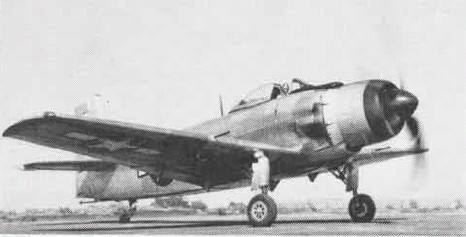
The first XBT2D-1 tested at NATC in April 1945.
Design of the Douglas AD Skyraider
(To come)
⚒ specifications AD-1 1945 |
|
| Dimensions (L-w-h): | 38 ft 10 in x 50 ft 0.25 in x 15 ft 8.25 in (11.84 x 15.24 x 4.78 m) |
| Wing area: | 400.33 sq ft (37.192 m2) |
| Airfoil: | root: NACA 2417; tip: NACA 4413 |
| Weight, empty | 11,968 lb (5,429 kg) |
| Weight, gross | 18,106 lb (8,213 kg) |
| Fuel Capacity: | 380 US gal (320 imp gal; 1,400 l) internal tanks |
| Propulsion | Wright R-3350-26WA Duplex-Cyclone 18-cyl ACRPE, 2,700 hp (2,000 kW) |
| Propeller | 4-bladed Aeroproducts constant-speed propeller |
| Speed, max. | 322 mph (518 km/h, 280 kn) at 18,000 ft (5,500 m) |
| Ceiling | 28,500 ft (8,700 m) |
| Climb Rate | 2,850 ft/min (14.5 m/s) |
| Range | 1,316 mi (2,118 km, 1,144 nmi) |
| Wing load | 46.6 lb/sq ft (228 kg/m2) |
| Power/mass | 0.149 hp/lb (0.245 kW/kg) |
| Armament: MGs | 4x 20 mm AN/M3 cannon with 200 rounds per gun |
| Armament: Payload | 15 external hardpoints, 8,000 lb (3,600 kg), see notes |
| Crew: | 1 pilot |

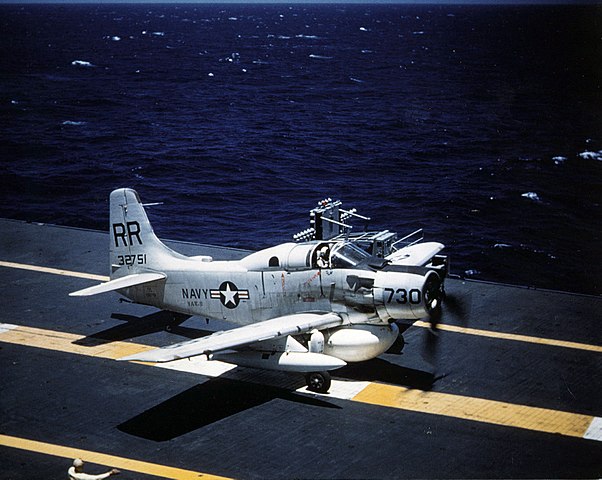


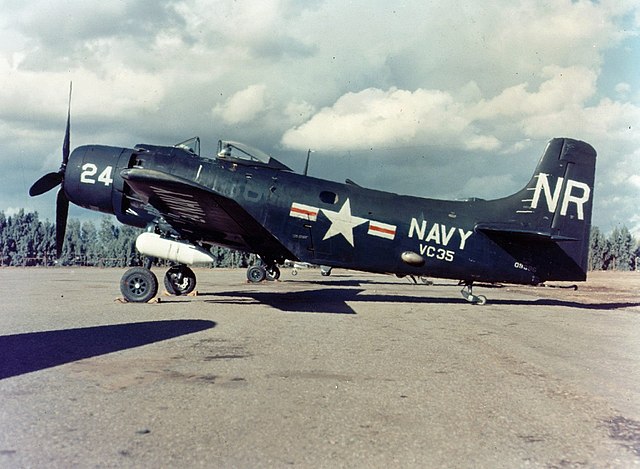
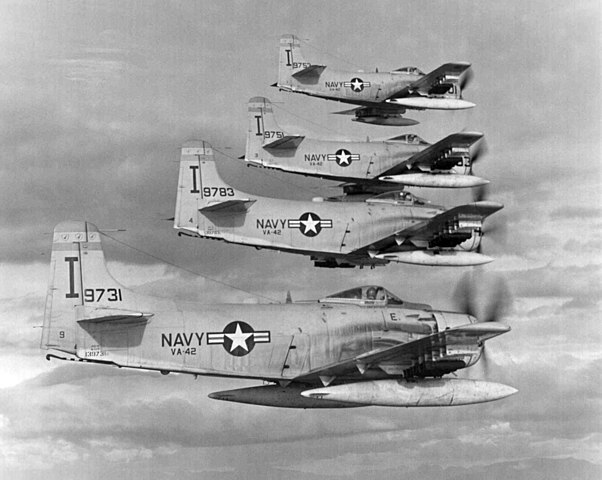
 Latest Facebook Entry -
Latest Facebook Entry -  X(Tweeter) Naval Encyclopedia's deck archive
X(Tweeter) Naval Encyclopedia's deck archive Instagram (@navalencyc)
Instagram (@navalencyc)





 French Navy
French Navy Royal Navy
Royal Navy Russian Navy
Russian Navy Armada Espanola
Armada Espanola Austrian Navy
Austrian Navy K.u.K. Kriegsmarine
K.u.K. Kriegsmarine Dansk Marine
Dansk Marine Nautiko Hellenon
Nautiko Hellenon Koninklije Marine 1870
Koninklije Marine 1870 Marinha do Brasil
Marinha do Brasil Osmanlı Donanması
Osmanlı Donanması Marina Do Peru
Marina Do Peru Marinha do Portugal
Marinha do Portugal Regia Marina 1870
Regia Marina 1870 Nihhon Kaigun 1870
Nihhon Kaigun 1870 Preußische Marine 1870
Preußische Marine 1870 Russkiy Flot 1870
Russkiy Flot 1870 Svenska marinen
Svenska marinen Søværnet
Søværnet Union Navy
Union Navy Confederate Navy
Confederate Navy Armada de Argentina
Armada de Argentina Imperial Chinese Navy
Imperial Chinese Navy Marinha do Portugal
Marinha do Portugal Mexico
Mexico Kaiserliche Marine
Kaiserliche Marine 1898 US Navy
1898 US Navy Sovietskiy Flot
Sovietskiy Flot Royal Canadian Navy
Royal Canadian Navy Royal Australian Navy
Royal Australian Navy RNZN Fleet
RNZN Fleet Chinese Navy 1937
Chinese Navy 1937 Kriegsmarine
Kriegsmarine Chilean Navy
Chilean Navy Danish Navy
Danish Navy Finnish Navy
Finnish Navy Hellenic Navy
Hellenic Navy Polish Navy
Polish Navy Romanian Navy
Romanian Navy Turkish Navy
Turkish Navy Royal Yugoslav Navy
Royal Yugoslav Navy Royal Thai Navy
Royal Thai Navy Minor Navies
Minor Navies Albania
Albania Austria
Austria Belgium
Belgium Columbia
Columbia Costa Rica
Costa Rica Cuba
Cuba Czechoslovakia
Czechoslovakia Dominican Republic
Dominican Republic Haiti
Haiti Hungary
Hungary Honduras
Honduras Estonia
Estonia Iceland
Iceland Eire
Eire Equador
Equador Iran
Iran Iraq
Iraq Latvia
Latvia Liberia
Liberia Lithuania
Lithuania Mandchukuo
Mandchukuo Morocco
Morocco Nicaragua
Nicaragua Persia
Persia San Salvador
San Salvador Sarawak
Sarawak Uruguay
Uruguay Venezuela
Venezuela Zanzibar
Zanzibar Warsaw Pact Navies
Warsaw Pact Navies Bulgaria
Bulgaria Hungary
Hungary

 Bundesmarine
Bundesmarine Dutch Navy
Dutch Navy Hellenic Navy
Hellenic Navy Marina Militare
Marina Militare Yugoslav Navy
Yugoslav Navy Chinese Navy
Chinese Navy Indian Navy
Indian Navy Indonesian Navy
Indonesian Navy JMSDF
JMSDF North Korean Navy
North Korean Navy Pakistani Navy
Pakistani Navy Philippines Navy
Philippines Navy ROKN
ROKN Rep. of Singapore Navy
Rep. of Singapore Navy Taiwanese Navy
Taiwanese Navy IDF Navy
IDF Navy Saudi Navy
Saudi Navy Royal New Zealand Navy
Royal New Zealand Navy Egyptian Navy
Egyptian Navy South African Navy
South African Navy






























 Ukrainian Navy
Ukrainian Navy dbodesign
dbodesign